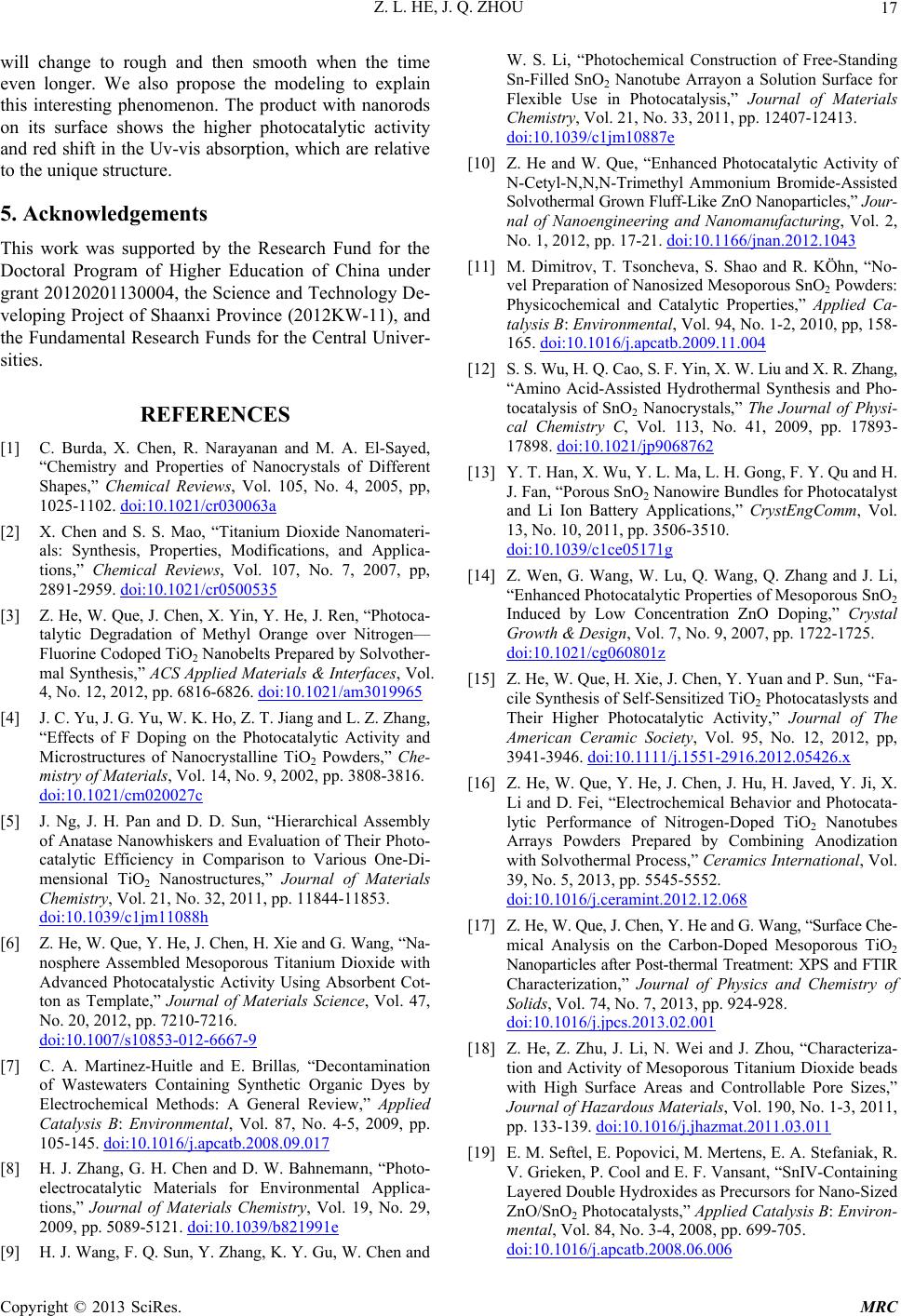
Z. L. HE, J. Q. ZHOU 17
will change to rough and then smooth when the time
even longer. We also propose the modeling to explain
this interesting phenomenon. The product with nanorods
on its surface shows the higher photocatalytic activity
and red shift in the Uv-vis absorption, which are relative
to the unique structure.
5. Acknowledgements
This work was supported by the Research Fund for the
Doctoral Program of Higher Education of China under
grant 20120201130004, the Science and Technology De-
veloping Project of Shaanxi Province (2012KW-11), and
the Fundamental Research Funds for the Central Univer-
sities.
REFERENCES
[1] C. Burda, X. Chen, R. Narayanan and M. A. El-Sayed,
“Chemistry and Properties of Nanocrystals of Different
Shapes,” Chemical Reviews, Vol. 105, No. 4, 2005, pp,
1025-1102. doi:10.1021/cr030063a
[2] X. Chen and S. S. Mao, “Titanium Dioxide Nanomateri-
als: Synthesis, Properties, Modifications, and Applica-
tions,” Chemical Reviews, Vol. 107, No. 7, 2007, pp,
2891-2959. doi:10.1021/cr0500535
[3] Z. He, W. Que, J. Chen, X. Yin, Y. He, J. Ren, “Photoca-
talytic Degradation of Methyl Orange over Nitrogen—
Fluorine Codoped TiO2 Nanobelts Prepared by Solvother-
mal Synthesis,” ACS Applied Materials & Interfaces, Vol.
4, No. 12, 2012, pp. 6816-6826. doi:10.1021/am3019965
[4] J. C. Yu, J. G. Yu, W. K. Ho, Z. T. Jiang and L. Z. Zhang,
“Effects of F Doping on the Photocatalytic Activity and
Microstructures of Nanocrystalline TiO2 Powders,” Che-
mistry of Materials, Vol. 14, No. 9, 2002, pp. 3808-3816.
doi:10.1021/cm020027c
[5] J. Ng, J. H. Pan and D. D. Sun, “Hierarchical Assembly
of Anatase Nanowhiskers and Evaluation of Their Photo-
catalytic Efficiency in Comparison to Various One-Di-
mensional TiO2 Nanostructures,” Journal of Materials
Chemistry, Vol. 21, No. 32, 2011, pp. 11844-11853.
doi:10.1039/c1jm11088h
[6] Z. He, W. Que, Y. He, J. Chen, H. Xie and G. Wang, “Na-
nosphere Assembled Mesoporous Titanium Dioxide with
Advanced Photocatalystic Activity Using Absorbent Cot-
ton as Template,” Journal of Materials Science, Vol. 47,
No. 20, 2012, pp. 7210-7216.
doi:10.1007/s10853-012-6667-9
[7] C. A. Martinez-Huitle and E. Brillas, “Decontamination
of Wastewaters Containing Synthetic Organic Dyes by
Electrochemical Methods: A General Review,” Applied
Catalysis B: Environmental, Vol. 87, No. 4-5, 2009, pp.
105-145. doi:10.1016/j.apcatb.2008.09.017
[8] H. J. Zhang, G. H. Chen and D. W. Bahnemann, “Photo-
electrocatalytic Materials for Environmental Applica-
tions,” Journal of Materials Chemistry, Vol. 19, No. 29,
2009, pp. 5089-5121. doi:10.1039/b821991e
[9] H. J. Wang, F. Q. Sun, Y. Zhang, K. Y. Gu, W. Chen and
W. S. Li, “Photochemical Construction of Free-Standing
Sn-Filled SnO2 Nanotube Arrayon a Solution Surface for
Flexible Use in Photocatalysis,” Journal of Materials
Chemistry, Vol. 21, No. 33, 2011, pp. 12407-12413.
doi:10.1039/c1jm10887e
[10] Z. He and W. Que, “Enhanced Photocatalytic Activity of
N-Cetyl-N,N,N-Trimethyl Ammonium Bromide-Assisted
Solvothermal Grown Fluff-Like ZnO Nanoparticles,” Jour-
nal of Nanoengineering and Nanomanufacturing, Vol. 2,
No. 1, 2012, pp. 17-21. doi:10.1166/jnan.2012.1043
[11] M. Dimitrov, T. Tsoncheva, S. Shao and R. KÖhn, “No-
vel Preparation of Nanosized Mesoporous SnO2 Powders:
Physicochemical and Catalytic Properties,” Applied Ca-
talysis B: Environmental, Vol. 94, No. 1-2, 2010, pp, 158-
165. doi:10.1016/j.apcatb.2009.11.004
[12] S. S. Wu, H. Q. Cao, S. F. Yin, X. W. Liu and X. R. Zhang,
“Amino Acid-Assisted Hydrothermal Synthesis and Pho-
tocatalysis of SnO2 Nanocrystals,” The Journal of Physi-
cal Chemistry C, Vol. 113, No. 41, 2009, pp. 17893-
17898. doi:10.1021/jp9068762
[13] Y. T. Han, X. Wu, Y. L. Ma, L. H. Gong, F. Y. Qu and H.
J. Fan, “Porous SnO2 Nanowire Bundles for Photocatalyst
and Li Ion Battery Applications,” CrystEngComm, Vol.
13, No. 10, 2011, pp. 3506-3510.
doi:10.1039/c1ce05171g
[14] Z. Wen, G. Wang, W. Lu, Q. Wang, Q. Zhang and J. Li,
“Enhanced Photocatalytic Properties of Mesoporous SnO2
Induced by Low Concentration ZnO Doping,” Crystal
Growth & Design, Vol. 7, No. 9, 2007, pp. 1722-1725.
doi:10.1021/cg060801z
[15] Z. He, W. Que, H. Xie, J. Chen, Y. Yuan and P. Sun, “Fa-
cile Synthesis of Self-Sensitized TiO2 Photocataslysts and
Their Higher Photocatalytic Activity,” Journal of The
American Ceramic Society, Vol. 95, No. 12, 2012, pp,
3941-3946. doi:10.1111/j.1551-2916.2012.05426.x
[16] Z. He, W. Que, Y. He, J. Chen, J. Hu, H. Javed, Y. Ji, X.
Li and D. Fei, “Electrochemical Behavior and Photocata-
lytic Performance of Nitrogen-Doped TiO2 Nanotubes
Arrays Powders Prepared by Combining Anodization
with Solvothermal Process,” Ceramics International, Vol.
39, No. 5, 2013, pp. 5545-5552.
doi:10.1016/j.ceramint.2012.12.068
[17] Z. He, W. Que, J. Chen, Y. He and G. Wang, “Surface Che-
mical Analysis on the Carbon-Doped Mesoporous TiO2
Nanoparticles after Post-thermal Treatment: XPS and FTIR
Characterization,” Journal of Physics and Chemistry of
Solids, Vol. 74, No. 7, 2013, pp. 924-928.
doi:10.1016/j.jpcs.2013.02.001
[18] Z. He, Z. Zhu, J. Li, N. Wei and J. Zhou, “Characteriza-
tion and Activity of Mesoporous Titanium Dioxide beads
with High Surface Areas and Controllable Pore Sizes,”
Journal of Hazardous Materials, Vol. 190, No. 1-3, 2011,
pp. 133-139. doi:10.1016/j.jhazmat.2011.03.011
[19] E. M. Seftel, E. Popovici, M. Mertens, E. A. Stefaniak, R.
V. Grieken, P. Cool and E. F. Vansant, “SnIV-Containing
Layered Double Hydroxides as Precursors for Nano-Sized
ZnO/SnO2 Photocatalysts,” Applied Catalysis B: Environ-
mental, Vol. 84, No. 3-4, 2008, pp. 699-705.
doi:10.1016/j.apcatb.2008.06.006
Copyright © 2013 SciRes. MRC